- Home
- Robert J. Mrazek
A Dawn Like Thunder
A Dawn Like Thunder Read online
Copyright © 2008 by Robert J. Mrazek
All rights reserved. Except as permitted under the U.S. Copyright Act of 1976, no part of this publication may be reproduced, distributed, or transmitted in any form or by any means, or stored in a database or retrieval system, without the prior written permission of the publisher.
Little, Brown and Company
Hachette Book Group
237 Park Avenue, New York, NY 10017
Visit our Web site at www.HachetteBookGroup.com
First eBook Edition: December 2008
Little, Brown and Company is a division of Hachette Book Group, Inc.
The Little, Brown name and logo are trademarks of Hachette Book Group, Inc.
ISBN: 978-0-316-04098-3
Book design by Fearn Cutler de Vicq
Maps by Julie Krick
Contents
Introduction
The Sentinels
Smiley
The Skipper
Swede
The Squire
Old Langdon
Tex
Bert and Harry
Grant and Whitey
Ozzie and Rete
Freddy
Eventide
He That Shall Live
When the Sea
Sister Sara
Dog Day
The Galloping Dragon
Resurrection Blues
The Canal
The Groove
Divine Fire
Out of the Ashes
Swede’s Refrain
Homeward Bound
Epilogue
Appendix One
Appendix Two
Acknowledgments
Photograph Captions and Credits
Sources
Author Interviews
Bibliography
About the Author
Also by Robert J. Mrazek
The Deadly Embrace
Unholy Fire
Stonewall’s Gold
For my son,
1st Lieutenant James Nicholas Mrazek, U.S. Army,
1st Battalion, 501st Parachute Infantry Regiment,
Forward Operating Base-ISKAN, Iskandariah, Iraq
(2006–2007)
They did their share.
“An’ the dawn comes up like thunder. . .”
Rudyard Kipling
“Many men who never received mention
gave everything they had — they’re still out there.”
Gregory Boyington (USMC)
“Below the sea of clouds lies eternity.”
Antoine de Saint-Exupéry
Ensign William Robinson Evans Jr., age 23
Pilot, Torpedo Squadron Eight
Norfolk, Virginia
December 7, 1941
My dear family,
What a day — the incredulousness of it all still gives each new announcement of the Pearl Harbor attack the unreality of a fairy tale. How can they have been so mad? Though I suppose we have all known it would come sometime, there was always that inner small voice whispering — no, we are too big, too rich, too powerful, this war is for some poor fools somewhere else. It will never touch us here. And then this noon that world fell apart.
Today has been feverish, not with the excitement of emotional crowds cheering and bands playing, but with the quiet conviction and determination of serious men settling down to the business of war. Everywhere little groups of officers listening to the radio, men hurrying in from liberty, quickly changing clothes, and reporting to battle stations. Scarcely an officer seemed to know why we were at war and it seemed to me there is a certain sadness for that reason. If the reports I’ve heard today are true, the Japanese have performed the impossible, have carried out one of the most daring and successful raids in all history. They knew the setup perfectly — got there on the one fatal day — Sunday — officers and men away for the weekend or recovering from Saturday night. The whole thing was brilliant. People will not realize, I fear, for some time how serious this matter is, the indifference of labor and capital to our danger is an infectious virus and the public has come to think contemptuously of Japan. And that I fear is a fatal mistake. Today has given evidence of that. This war will be more difficult than any war this country has ever fought.
Tonight I put away all my civilian clothes. I fear the moths will find them good fare in the years to come. There is such a finality to wearing a uniform all the time. It is the one thing I fear — the loss of my individualism in a world of uniforms. But kings and puppets alike are being moved now by the master — destiny.
It is growing late and tomorrow will undoubtedly be a busy day. Once more the whole world is afire — in the period approaching Christmas it seems bitterly ironic to mouth again the timeworn phrases concerning peace on earth — goodwill to men, with so many millions hard at work figuring out ways to reduce other millions to slavery or death. I find it hard to see the inherent difference between man and the rest of the animal kingdom. Faith lost — all is lost. Let us hope tonight that people, all people throughout this great country, have the faith to once again sacrifice for the things we hold essential to life and happiness. Let us defend these principles to the last ounce of blood — but then above all retain reason enough to have “charity for all and malice toward none.” If the world ever goes through this again — mankind is doomed. This time it has to be a better world.
All my love,
Bill
Introduction
Following its devastating attack on Pearl Harbor, the Japanese Empire embarked on one of the most stunning military campaigns in world history, conquering the American-held Philippines, the mighty British fortress of Singapore, Java, Malaya, the oil-rich Dutch East Indies, Sumatra, Hong Kong, Guam, and Wake Island. In the process, they virtually annihilated the Far Eastern fleets of Great Britain, the United States, Australia, and the Netherlands.
In less than six months, the Japanese killed or captured more than five hundred thousand Allied soldiers, and came to control the destiny of one hundred fifty million new subjects. They had conquered an empire that it took the Western colonial powers almost four centuries to acquire.
Along the Pacific coast of the United States, panic-stricken Americans feared an imminent invasion. In February 1942, President Roosevelt ordered 112,000 Japanese-Americans to be rounded up and sent to detention camps. It was a time of apprehension and alarm. For most Americans, the outcome of the war was in genuine doubt.
In early May 1942, American code breakers deduced from intercepted radio messages that the Japanese Imperial Navy was planning to eliminate the U.S. presence in the Central Pacific by drawing American forces into a final and decisive battle. Their target was Midway Atoll, consisting of two islands and an airfield lying twelve hundred miles west of Hawaii. Gambling that his code breakers were right, Admiral Chester Nimitz, the commander-in-chief of the U.S. Pacific Fleet, committed his available forces to setting up an ambush.
Midway has been called the most important naval battle ever fought between two great powers. The Japanese thought it would be a walkover, or in the words of one senior Japanese officer, “as easy as twisting a baby’s arm.” After everything their navy had accomplished up to that point, there was little reason to doubt his words.
The Japanese Empire was at the pinnacle of its glory. Having destroyed the last vestiges of European colonial power in the western Pacific, their confidence in their commanders, warships, combat aircraft, and each other was boundless. Many had come to believe that they were racially superior to the “mongrelized” and “decadent” Americans.
Against the five Japanese battleships, eight aircraft carriers, fourteen cruisers, fifty-five destroyers, and dozens of auxiliary ships now heading toward Midway, A
dmiral Nimitz had a combined force of three carriers, eight cruisers, and thirteen destroyers. Twenty-four ships against one hundred sixty-two.
Only two of his carriers, the Hornet and the Enterprise, were prepared for battle. His third carrier, the USS Yorktown, had absorbed a five-hundred-pound bomb hit in the Battle of the Coral Sea. Informed that the ship would require at least a month to be made seaworthy, Nimitz gave his repair division seventy-two hours to accomplish the task.
In spite of these fearful odds, on June 4, 1942, the Americans chose to confront the Imperial Navy at Midway. In assessing the battle’s importance, former defense secretary James Schlesinger wrote that “it was far more than the turning of the tide in the Pacific War. In a strategic sense, it was a turning point in world history.”
Just two months later, the second pivotal battle of the Pacific War was fought on the island of Guadalcanal. Guadalcanal was the land-based strategic equivalent of Midway, a savage and bloody campaign that determined the outcome of Japanese aspirations to secure control of its vast new Pacific empire.
Unlike Midway, the battle took place in malarial swamps and sweltering jungle, as well as in the skies above them. It is doubtful that a more harrowing succession of weeks ever took place in the history of warfare. Guadalcanal was the first of many Pacific campaigns in which the Japanese fought to virtually the last man. The challenge was compounded for the Americans by the fact that they were cut off from support, and existing in part on supplies left behind by the Japanese. “For those who fought there,” wrote Admiral Samuel Eliot Morison, “Guadalcanal was not just a name. . . . It was an emotion.”
The Americans went into both of these crucial battles with vastly inferior forces. If the Japanese had won at Midway, they would have been free to advance eastward, taking the Hawaiian Islands and threatening the West Coast of the United States. President Roosevelt would have been forced to abandon his strategy of fighting Germany first. History might well have turned out quite differently.
The story of these two pivotal battles has been written many times and far too well for me to replicate them once again. This book is not about the battles. It is about one small group of men who fought in both of them.
A Dawn Like Thunder tells the story of one naval air squadron, a group of young Americans from every part of the country who began the war flying outmoded aircraft that launched unreliable torpedoes against enemy warships.
Through a combination of courage, sacrifice, luck, and timing, it was the fate of these men to help change the course of history. More than sixty years later, the record of their contribution has faded into the past, and the last handful of survivors provide the only living link to their deeds in the first critical months of the Second World War.
This book was not written to mythologize war. In the twenty-first century, that would be a sacrilege. All but a few of the men depicted in the book were fighting to help win what they hoped would be a lasting peace, and then to come home and enjoy the rest of their lives.
The novelist Stephen Crane was once asked why he wrote The Red Badge of Courage. “I wanted to be there,” he said. That is the goal of this book, to again bring alive on the page these extraordinary young men, who they were and what they did, for a modern generation of readers.
This is their story.
THE SENTINELS
Smiley
FRIDAY, 29 MAY 1942
USS CHAUMONT
TORPEDO SQUADRON EIGHT
His first glimpse of the Hawaiian Islands was just a distant smudge on the sun-splashed sea, but it was enough for him to feel a shiver of excitement. Like many of the Navy pilots crossing the Pacific on the military transport Chaumont, twenty-four-year-old Ensign Corwin F. Morgan of Tampa, Florida, savored the prospect of high adventure awaiting him aboard the aircraft carrier USS Hornet.
They called him Smiley.
With his rugged, square-jawed face, he didn’t look like a Smiley, and he didn’t smile more than any other pilot in Torpedo Squadron Eight. Morgan had earned his enduring nickname at a poker game back in Norfolk, Virginia, after joining the torpedo squadron shortly before the Japanese attacked Pearl Harbor.
Rain had washed out the afternoon’s training flights, and a group of pilots had started playing poker. The game went on most of the night. Morgan was an inspired gambler, and had won more than two hundred dollars when someone started dealing blackjack and he encountered a run of terrible cards, losing hand after hand. The sudden twist of luck struck him as absurd, and he couldn’t stop grinning as he gave back half of what he had won.
“I can’t believe you, Morgan,” said James Hill Cook, the boyish-looking Southerner with the deep drawl from Grand Cane, Louisiana. “You smile when you win and you smile when you lose. From now on, I’m calling you Smiley.”
The name stuck.
Smiley Morgan had grown up in Richmond, Missouri, the self-proclaimed mushroom capital of the world. His father was the local veterinarian. One summer afternoon the boy had been dozing near a swimming hole at his grandfather’s farm when he happened to gaze up and notice a flight of barnstormers doing loops and barrel rolls over the county fairgrounds a couple miles away. Like a youth answering a religious calling, he had tramped through cornfields and pastures until he finally reached the fairgrounds, where he stood mesmerized next to his first airplane.
At the University of Florida in Gainesville, he proved to be an exceptional athlete, and a not-so-motivated student. Before he dropped out of college, he joined the Civilian Pilot Training Program and earned his flying license. Deciding to join the Navy, he was accepted for flight training. After he won his wings in Pensacola, Florida, Morgan was assigned to Torpedo Squadron Eight in Norfolk, Virginia.
When he arrived at East Field in Norfolk, he was told to report to the squadron’s commanding officer. Lieutenant Commander John Waldron had just returned from a training flight, and was still wearing his flight suit. He kept Morgan standing at attention in his office while he quickly signed a batch of papers. Looking down at Waldron as he worked, Smiley thought he looked old enough to be his father, and then some.
“Ensign,” said Waldron without looking up, “I am going to give you your first duty in this squadron. Go over to the blackboard and print your name.”
Smiley wrote, “Corwin F. Morgan.”
Standing up, Waldron repeated it aloud and came over to shake his hand. His fierce-looking face looked gaunt. The imprint of flying goggles was etched on his cheeks.
There was a lot for him to learn about flying a torpedo plane, he said, and he would have to work hard to master it all. They started every morning before dawn, and worked until well after dark.
“Welcome to the outfit,” he concluded.
That was one of the few times Smiley ever talked to the Skipper alone. Nine days later, the Japanese attacked Pearl Harbor. From then on, Waldron ran the squadron like there was no tomorrow, seven days a week without letup. Smiley had never worked harder in his life. As the months passed, he began to feel a deep sense of pride at having mastered flying in every kind of weather and at all hours of the day and night.
Now he was on his way to war.
There had been little for the pilots to do aboard the Chaumont as it crossed the Pacific. During the day, they sunbathed on deck, ate their meals in the wardroom, exercised, studied torpedo attack problems, and read the dog-eared books and old magazines in the small wardroom library.
After dark, the ship was always blacked out in case a Japanese submarine lurked in their path. Morgan spent most of the night hours on the fantail with his friend Ensign John Taurman, a big, easygoing pilot from Cincinnati, Ohio. The two of them would sit against a stanchion, gazing backward as the ship’s wake cut a crystal path behind them in the roiling sea, wondering what would await them when they finally arrived at Pearl Harbor.
Torpedo Squadron Eight had been temporarily split in half back in Norfolk. In early March 1942, Lieutenant Commander Waldron and most of the senior pilots had gone to s
ea aboard the carrier Hornet, sailing for the West Coast via the Panama Canal, after which the carrier headed out to the Pacific to engage the Japanese. Waldron’s squadron was equipped with the Navy’s outmoded torpedo plane, the Douglas TBD Devastator.
The second half of the squadron had stayed behind in Norfolk to receive delivery of the Navy’s brand-new torpedo attack plane, the Grumman TBF Avenger. After the new planes had been flight-tested, Smiley and the rest of the pilots had flown them across the United States. In San Francisco, the crews and their aircraft had been put aboard fast transport ships. Their goal was to catch up to the Hornet before the next big battle against the Japanese.
The sea was almost flat calm as the Chaumont finally turned for the final leg of the passage between Molokai and Oahu, the islands lush and inviting beneath green mountains under the midday sun.
All of the pilots crowded the deck railing to get their first look at Pearl Harbor. Like the others, the twenty-four-year-old Morgan had seen the newspaper and magazine photographs of the devastation caused by the Japanese attack less than six months earlier. He thought he was prepared for what they would see. He was wrong.
After passing through the submarine nets protecting the entrance to the harbor, the Chaumont steamed slowly past Battleship Row. Lying upside down at one mooring, the capsized Oklahoma was dull brown in the sunlight. More than two football fields long, its rust-covered hull rose above the oily surface like a humpback whale. Next in line lay the battleship West Virginia, which had sunk at its mooring after taking six torpedoes and two armor-piercing bombs.
Farther down the anchorage, a small utility vessel was tethered next to the shattered wreck of the Arizona, its work party of salvage divers trying to start a gas engine suction pump.
What remained of the Arizona’s superstructure above the waterline was nothing more than a rusting mass of battered metal. The officers’ boisterous shouting suddenly ceased, and they sailed slowly past it in awestruck silence. If there was any lingering doubt about what they were fighting for, it ended there.

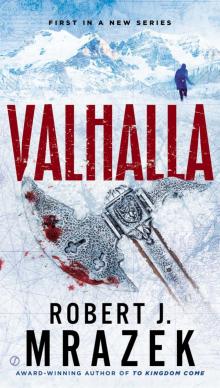 Valhalla
Valhalla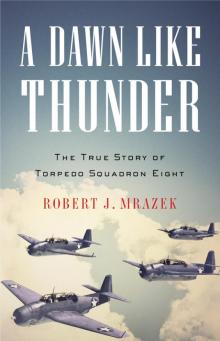 A Dawn Like Thunder
A Dawn Like Thunder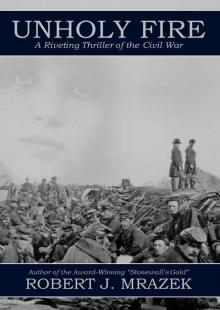 Unholy Fire
Unholy Fire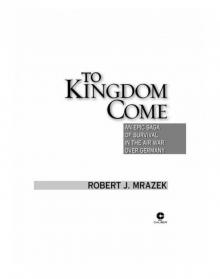 To Kingdom Come
To Kingdom Come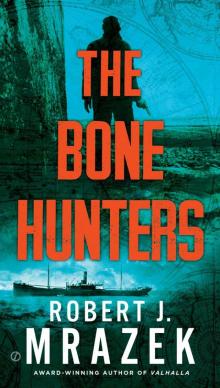 The Bone Hunters
The Bone Hunters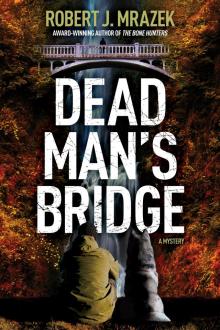 Dead Man's Bridge
Dead Man's Bridge